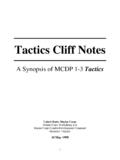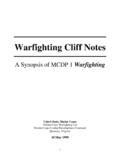Transcription of Wynd Cliff - climbers-club.co.uk
1 42 wynd CliffOS Ref ST 527 973 wynd Cliff is the set of sunny crags visiblefrom Wintour s Leap, the traditional pairappearing high on the hillside as you round a bend approaching the ForestryCommission Lower Wyndcliff car park and picnic area when driving north on theA446. The place has been a popular beauty spot since the construction of the 365 Steps path up to the Eagle s Nest lookout for the Duke of Beaufort in 1828. As theinformation board in the car park observes, The view from the Eagle s Nest lookouthas to be one of the best in the Wye Valley. Look across the bend in the Wye to see therocks of Wintour s Leap, the Severn bridges and estuary and, on a clear day, theCotswold and Mendip hills.
2 It s true, and that s one reward you get from the belay atthe top if you two upper crags are left and right respectively, of the 365 Steps path, whichserves as an approach and useful descent. The climbing is steep and sustained with thebest of the routes following strong natural lines such as grooves or cracks, safe andsound on the right, more adventurous and exciting on the left. They are all single pitchbut they have a big feel to them. The grades range from Severe to mid Extreme, sothere s something for everyone except those looking for the right and only just above the road is Wyndcliff Quarry, containing predominantlyshort sport climbs for sunny evenings or when the upper crags are wet. A mile along theroad towards Tintern is the smaller, slightlyscruffy Black Cliff Quarry with a collection ofshorter and mainly easier partlyor fully bolt-protected the late 60s, the crags lay discrete behind a relentless blanket of ivy.
3 Viewed fromWintour s Leap, they appeared as unlikely andinsignificant as, say, do the PiercefieldRocks (a little to the south) today. But when the Severn Bridge opened and climbersfrom Bristol and the South West started using the Wye Valley road to motor to NorthWales, a close-up view from immediately below told a different tale. Frank Canningsand Pat Littlejohn investigated and had soonpulledenoughivyofftorevealthetwobest continued to frequent the crag with Littlejohn and various other partners for acouple of years, and several more routes followed. Clive Horsfield and Phil Watkinworked hard at the left end and between them accounted for the first seven climbs inthe guide. Watkin was founder-editor ofRocksport,thefirstbraveattemptataBriti shall-rock-climbing magazine, and early activities were well publicized, not least byCannings, who produced an interim guide.
4 The crag buzzed with enthusiasm andactivity and for some time became the most fashionable in the Wye Valley, attracting,especially, enterprising members of the Cheltenham MC. Chris Milford was the club sleading light at the time and in 1972 extended the list withShaft,Klute, this initial boom, wynd Cliff suddenly fell quiet for four years. But at the end of thelong hot summer of 76, when standards soared everywhere, E2 replaced VS as thenorm and Andy Sharp made his mark. Thereafter, with Wintour s Leap documentationin better order, and later Shorn Cliff and then Ban-y-gor being opened up, the WyeValley regulars were busy with new-routing elsewhere, finding only occasional briefforays worthwhile. The ivy started creeping quite eye-catching from a distance, Wyndcliff Quarry had been dismissed asloose and insignificant, but it possessed two major virtues: immediate accessibility andseemingly permanent sunshine, which in 1990 inspired Gordon Jenkin, Andy Tallant,and others to make available some fun routes with bolts.
5 A few years later, Pete Riley,involved with forestry work in the area, climbed a string of rather-less-fun routes without bolts. Martyn Cattermole took time out from Tintern Quarry to switch theemphasis back to sport climbing here, and also discovered Black Cliff Quarry up theroad. This was when the rumpus occurred, and the two quarries were quarantined year 2006 saw a late flourish as Tim Wilkinson, charged with putting the wynd Cliffhouse in order for the guide, and Jenkin, regearing his earlier routes for posterity,started working the remaining quarry possibilities. Martin Crocker, perhaps in reactionto spending three consecutive winters at dizzy heights restoring the grand rocks ofCheddar and GO Wall, walked past one day and saw what was going on.
6 Neverafraid to use bolts when he considers they will enhance the climbing, he takes delight indemonstrating an even greater enhancement in unexpectedly doing without usually pronounce wynd to rhyme with binned , while locals make it rhymewith bind . The locals are correct. In Middle English,windis often found speltwyndinboth its meanings/pronunciations. Here it almost certainly refers to the sharp bends inthe hillside (most notably that between the two main crags) following the winding rivervalley below. The e at the end of Cliff is another relic of bygone days and seems nowconfined solely to the old road signpost just north of St Arvans. We have followed theOS practice of treating the Main Crags name as two words (matching Shorn Cliff ) butrunning it into one where it serves as an adjective before wood , quarry , car park.
7 Climbers on the Left-Hand CragSinew(HVS) andFibre(VS)DON SARGEANTThe Main CragsThe routes have undergone a process of natural selection over the years with thepoorer routes seeing little traffic and beingreclaimed by vegetation and, conversely, thebetter ones receiving more attention, stayingclean, and even a getting little polished. As aconsequence of the above, in addition to amorededicatedprogrammeofrefurbishment, all of the routes described herein full are in good condition at the time ofwriting and their quality and popularity shouldkeep them that crags are generally refreshingly free ofin-situprotection but what little there is waschecked in 2005/6 and replaced if criticaland Left-Hand Crag faces south-east and theRight-Hand Crag faces south-west, so theymake a great winter venue, though the treestend to shade the latter a little more than simplest approach is from the LowerWyndcliff car park.
8 Across the road is a its barrier; then turn right (facing a smallold quarry) and follow the 365 Steps path as itzigzags up through the woods, and in lessthan ten minutes the crags will appearthrough the trees. For the Right-Hand Crag, leave thepath sharply rightwards on a straightsection before it passes amongstsome rocks. Then follow rough rockysteps up to the foot of the crag. For the Left-Hand Crag, leave thepath leftwards at a bend after a set ofrailings where there is a three-trunkedtree, a yew, and a boulder. Thencontour over mossy boulders to theright-hand end of the same routes can be reached from above if you park in the Upper Wyndcliff car parkand follow the Wye Valley Walk northwards towards (but not quite to) the Eagle s Nest, andthen descend the steel staircase at the top of the 365 Steps path.
9 The Left-Hand Crag canalso be reached by scrambling up through the small old quarry just past the barrier, andthen through the woods to a large trench, which is crossed leftwards to the foot of the crag,but this can be confusing on a first CliffTo descend from the routes, either abseil from the trees on the lip of the crag, or top out byscrambling up to the higher paths in the woods, and then descend the steel of the exits on the right-hand side of the Left-Hand Crag have been somewhatunfairly likened to vertical jungles in the past. However, during the preparation of thisguide all exits were thoroughly cleaned, and knotted ropes have been attached to thenearest substantial tree on the worst to safeguard a CragThe crag is divided above its lowest point by a large,brambled ledge-system, left of which is a series ofcorners, grooves, and cracks.
10 To the right are morepronounced grooves, which give substance to thebetter climbing on this Cliff . From the lowest point, apath leads up left to a large yew tree just right ofvegetation, which is an ideal base for routes on the farleft section of the route was climbed outside the permitted climbing area but should not be (37m HS ) took a groove/chimney line, leading to a flake and poor exit. Strike40m HS 4b( )The obvious, right-facing corner to the left of the large yew is followed to a ledge on itsright. Climb up to beneath an overhang; then traverse back left, taking care with thedubious flakes above. (This point can be reached direct from the ground at 4c.) Follow thecrack to a peg on the right, and then the continuation of the crack on the left to the next two routes both have some loose or vegetated sections requiring care andexperience at the VS 4c( )Five metres right of the corner and directly behind the yew is a shattered ar te.





